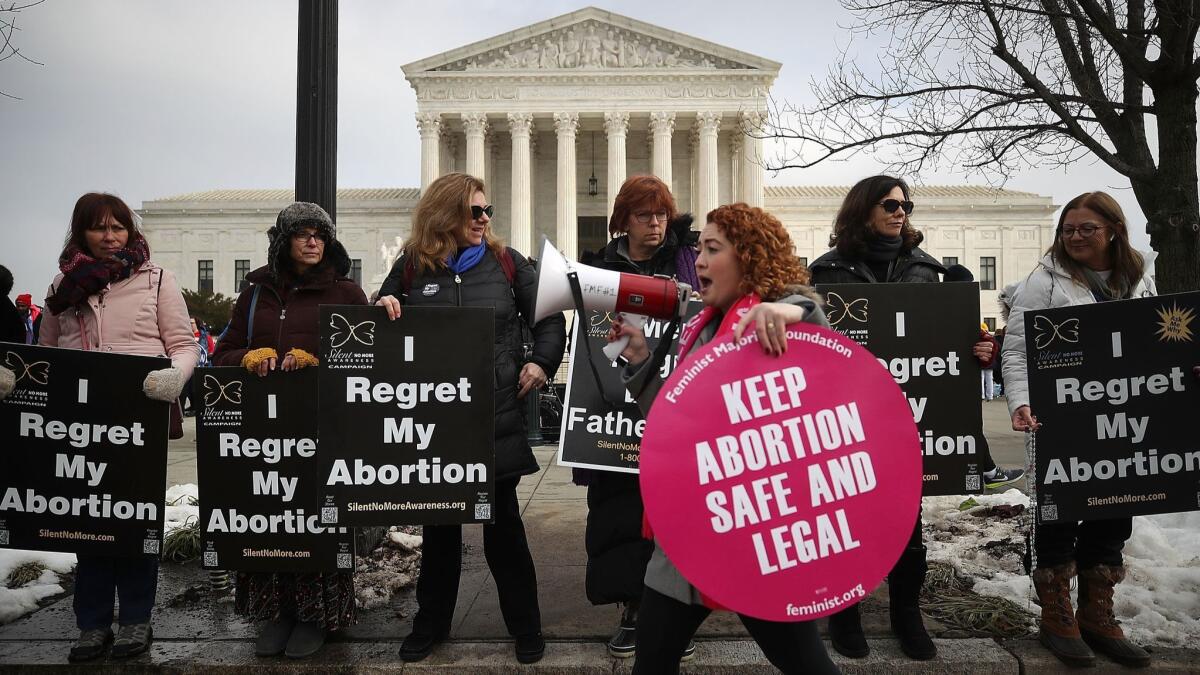California calls itself a ‘reproductive freedom’ state. Here’s how it can make good on that

- Share via
Nearly 50 years ago this week, the U.S. Supreme Court legalized abortion with its decision in Roe vs. Wade. Here in California, we’re the lucky ones: Access to abortion is relatively good, especially in cities. But the same isn’t true throughout the country. State governments in the Midwest and South have continuously ramped up restrictions to make abortions difficult, if not impossible, for their residents to obtain. With five conservatives on the Supreme Court as it prepares to hear a case in March that could allow for even more restrictive abortion laws, the situation is likely going to get worse before it gets better.
Women from states where abortion access is being legislated out of reach will undoubtedly travel to California to seek safe abortion care, and our government can and should do more to help them get it. In June, California Democrats declared ours to be a “reproductive freedom” state. The Legislature and the governor must take action to make that statement a reality.
Patients who need to travel far for abortion care may face delays and higher expenses as they arrange for transportation, lodging and other support in an unfamiliar state. The need to travel often causes women to obtain abortions later in pregnancy, which in itself can drive up the medical cost of the procedure. California — which helps its own residents pay for abortions through Medi-Cal and which requires insurance plans sold in the state to cover abortion — could be the first state to designate funding for abortion services for women who travel here from elsewhere for treatment.
New York City has already created a model to address the situation: It announced plans in June to allocate $250,000 to the nonprofit New York Abortion Access Fund to help pay for medical care, travel expenses and lodging for out-of-state women.
New York’s access fund is part of a national network of similar organizations, including California’s ACCESS Women’s Health Justice, headquartered in Oakland since 1993. Knowing that an increase in out-of-state patients is likely, Sacramento could follow New York’s lead and allocate funding to support the work ACCESS does.
In addition to providing more resources for patients coming from other states, we need to train more doctors and nurses in safe abortion care. All obstetrics and gynecology residency programs are required to include abortion training in their curriculum, but options for local training may become scarce for residents in states with growing restrictions. California could earmark funding specifically to support abortion training and it could streamline licensing requirements — any doctor training at a California facility must first be licensed here — to make it easy for out-of-state doctors to obtain the skills they need.
While most restrictions on abortion care are imposed at the state level, some are federal, and we should explore here in California how we might work around them. For example, the Food and Drug Administration requires doctors to stock the abortion pill, also known as mifepristone or RU-486, in their offices, rather than prescribing it for pickup at a pharmacy. This requirement is not medically necessary, and it prevents many OB-GYNs, who don’t want to set up their offices to be pharmacies as well as doctor offices, from providing medication abortions. In the same way that states have legalized marijuana despite federal laws, there may be a way for California’s government to mitigate this restriction.
Finally, California has designated taxpayer money for medical research in the past, for stem cell studies, for example, and studies related to lesbian, bisexual and queer women’s healthcare. The state should do the same for research that pushes the envelope on access to reproductive health services, supporting work that may only be possible here and in a few other states. (Full disclosure: I conduct such research.)
Careful testing of innovative strategies can expand access to safe abortion. One example: A study I led in Iowa showed that telemedicine, facilitated by rural clinics, can link women to abortion services (the abortion pill) safely and effectively. It increased abortion care early in pregnancy in Iowa, and it has provided a model for other states. Here in California, research on barriers students at our public universities faced in obtaining medication abortions provided crucial evidence that led to a new law requiring the schools to make the abortion pill available at campus health centers.
If states and the Supreme Court continue to curtail reproductive choices, California’s leaders should take up the challenge. With targeted funding and smart policies, our state has the opportunity to be an exemplary leader in expanding women’s rights.
Daniel Grossman, M.D., is a professor of obstetrics, gynecology and reproductive sciences at UC San Francisco and director of the research collaborative Advancing New Standards in Reproductive Health.
More to Read
A cure for the common opinion
Get thought-provoking perspectives with our weekly newsletter.
You may occasionally receive promotional content from the Los Angeles Times.









